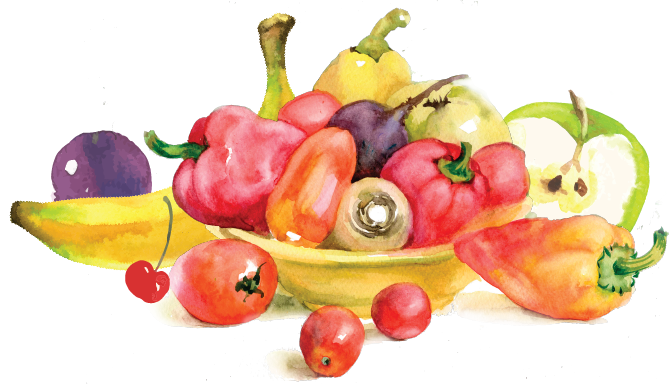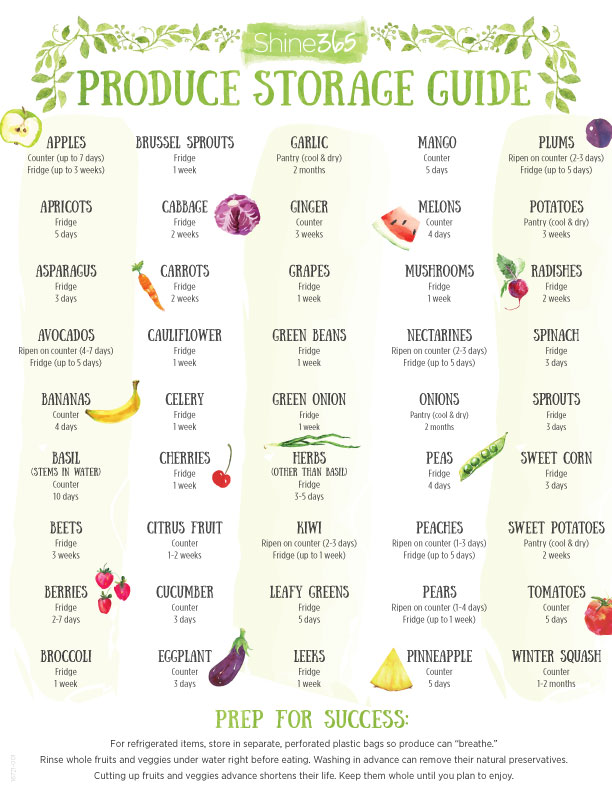
Tired of opening the refrigerator to find fruits and veggies you just brought home already are rotten?
Storing produce in the right place will help keep it fresh longer and help you stop wasting money each time you throw away rotten produce.
Keep produce fresh longer
Before you shop for produce, check the chart below to find out how long it’s expected to last. Wait to buy fruits and veggies if you don’t plan to use them in that time period.
“Check out the quality of produce before you leave the grocery store,” Marshfield Clinic dietitian Chrisanne Urban said. “Don’t buy something that’s bruised or discolored.”
 Tips to extend shelf life
Tips to extend shelf life
- Store fruits and veggies in separate refrigerator bins if they must be refrigerated.
- Store produce in vented bags or containers.
- Ripen produce in a paper bag if needed.
- Rinse produce with tap water shortly before eating. Never use detergent or bleach. Packaged fruits and vegetables labeled “washed” don’t need to be washed again.
- Cut fruits and veggies immediately before using. Slicing and dicing too soon shortens the life of your produce.
Some produce can be frozen if it’s near the end of its shelf life. Fruits and veggies with high water content, like watermelon, lettuce, cucumbers and celery, don’t freeze well.
If it’s already spoiled, throw it out, Urban said.
Skip special containers and produce sprays
Special storage containers for produce aren’t necessary to extend their shelf life. Any vented bag or container will work. Avoid products that don’t let air circulate around the produce.
Sprays designed to clean fruits and veggies also aren’t needed. Tap water is all you need to clean produce.
Guide to storing produce
Not sure how long fruits and veggies should last or where to store them?
Download and print this handy guide to storing produce. Keep it in your kitchen for quick reference.

| Produce Name | Where to Store | When to Toss |
|---|---|---|
| Apples | Counter (up to 7 days) then refrigerate | 3 weeks |
| Apricots | Fridge | 5 days |
| Asparagus | Fridge | 3 days |
| Avocados | Counter to ripen (4-7 days) then refrigerate | 5 days (once refrigerated) |
| Bananas | Counter | 4 days |
| Basil (in water) | Counter | 10 days |
| Beets | Fridge | 3 weeks |
| Berries | Fridge | 2 days – 1 week |
| Broccoli | Fridge | 1 week |
| Brussels sprouts | Fridge | 1 week |
| Cabbage | Fridge | 2 weeks |
| Carrots | Fridge | 2 weeks |
| Cauliflower | Fridge | 1 week |
| Celery | Fridge | 2 weeks |
| Cherries | Fridge | 3 days |
| Citrus fruit | Counter | 1-2 weeks |
| Cucumber | Counter | 3 days |
| Eggplant | Counter | 3 days |
| Garlic | Pantry (cool and dry) | 2 months |
| Ginger | Counter | 3 weeks |
| Grapes | Fridge | 1 week |
| Green beans | Fridge | 1 week |
| Green onion | Fridge | 1 week |
| Herbs (other than basil) | Fridge | 3-5 days |
| Kiwi | Counter to ripen (2-3 days) then refrigerate | 1 week (once refrigerated) |
| Leafy greens | Fridge | 5 days |
| Mangoes | Counter | 4 days |
| Melons | Counter | 4 days |
| Mushrooms | Fridge | 1 week |
| Nectarines | Counter to ripen (2-3 days) then refrigerate | 5 days (once refrigerated) |
| Onions | Pantry (cool and dry) | 2 months |
| Peas | Fridge | 4 days |
| Peaches | Counter to ripen (1-3 days) then refrigerate | 5 days (once refrigerated) |
| Pears | Counter to ripen (1-4 days) then refrigerate | 1 week (once refrigerated) |
| Pineapple | Counter | 5 days |
| Plums | Counter to ripen (2-3 days) then refrigerate | 5 days (once refrigerated) |
| Potatoes | Pantry (cool and dry) | 3 weeks |
| Radishes | Fridge | 2 weeks |
| Spinach | Fridge | 3 days |
| Sprouts | Fridge | 3 days |
| Summer squash | Fridge | 5 days |
| Sweet corn | Fridge | 3 days |
| Sweet potatoes | Pantry (cool and dry) | 2 weeks |
| Tomatoes | Counter | 5 days |
| Winter squash | Counter | 1-2 months |

